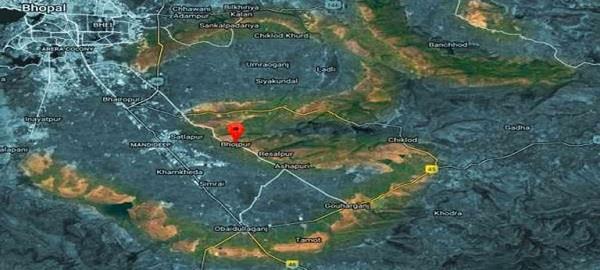
https://www.youtube.com/watch?v=X5XRc4GLzKs
Hi viewer. Welcome to my blog on Jyothir lingams.
We start with Shiva Manasa Pooja, which was given to us by Sri Adi Shankaracharya as an alternative simple pooja method for those busy with daily routines, finding it difficult to spend time for a detailed pooja, but are willing to still allocate 5 minutes anytime during the day. This method involves performing pooja in your mind, just by visualising the pooja procedures, as if it were done physically. According to Sri Adi Sankara, this would produce the same effect and is in no way considered inferior. Please click the following link if you have 5 minutes. Reciting this is equivalent to a detailed pooja.
The Legend of Jyothirlingam Lingam:
According to Shiva puraṇam, once Brahma - the lord of creation and Vishnu - the lord of Preservation, had an argument over supremacy. To settle the debate, Lord Shiva said that whosoever could find the top or bottom portion of his body would be considered as supreme. Lord Shiva pierced the three worlds appearing as an infinite pillar of light, "Jyothi".
Vishnu and Brahma split their ways to downward and upward directions respectively to find the end of the light in either directions. Brahma lied that he found out the top end, while Vishnu conceded his defeat. In support of his claim, Brahma gave an evidence of a flower called Thazhampoo. Since Lord Shiva knew that Brahma was lying, he cursed him that he would not be worshiped in a separate temple and the flower would not be accepted for worship.
The jyothirlingam shrines are places where Lord Shiva appeared as a fiery column of light. In all these temples, the primary deity is lingam representing the ‘beginning less’ and ‘endless’ pillar, symbolizing the infinite nature of Lord Shiva.
It is said that this infinite pillar of light that lord Shiva transformed into is called the Jyothirlingam. This later cooled to form the holy mountain of Annamalai, where the Arunachaleshwar temple is located, in Tamil Nadu.
The twelve Jyotir Lingams spread over the Indian sub-continent are:
- Somnath Jyotirlinga in Gir, Gujarat
- Mallikarjuna Jyotirlinga in Srisailam, Andhra Pradesh
- Mahakaleshwar Jyotirlinga in Ujjain, Madhya Pradesh
- Omkareshwar Jyotirlinga in Khanda, Madhya Pradesh
- Baidyanath Jyotirlinga in Deoghar, Jharkhand
- Bhimashankar Jyotirlinga in Maharashtra
- Ramanathaswamy Jyotirlinga in Rameshwaram, Tamil Nadu
- Nageshwar Jyotirlinga in Dwarka, Gujarat
- Kashi Vishwanath Jyotirlinga in Varanasi, Uttar Pradesh
- Trimbakeshwar Jyotirlinga in Nasik, Maharashtra
- Kedarnath Jyotirlinga in Rudraprayag, Uttarakhand
- Ghrishneshwar Jyotirlinga in Aurangabad, Maharashtra
The Jyothirlingam in all Shiva temples is worshiped in the form of Lingothbavar which is located just behind the sanctum sanctorum. Each of the 12 jyotirlinga sites take the name of a different manifestation of Shiva. At all these sites, the primary image is a lingam representing the beginning-less and endless stambha (pillar), symbolizing the infinite nature of Shiva. It is believed that there are 64 such Jyothirlingam shrines but 12 of them are considered as the most important and most auspicious. You have have a quick glance of these 12 shrines in the following link:
https://www.youtube.com/watch?v=crqPy6hFVfY

Jyothirlinga Slokam
https://www.youtube.com/watch?v=ILdyoggNhX8
“Saurashtre Somanathamcha Srisaile Mallikarjunam|
Ujjayinya Mahakalam Omkaramamaleswaram ||
Paralyam Vaidyanathancha Dakinyam Bheema Shankaram |
Setu Bandhethu Ramesam, Nagesam Darukavane||
Varanasyantu Vishwesam Tryambakam Gautameethate|
Himalayetu Kedaaram, Ghrishnesamcha shivaalaye||
Etani jyotirlingani, Saayam Praatah Patennarah|
Sapta Janma Kritam papam, Smaranena Vinashyati||”
We now proceed to have detailed look at these 12 places of worship in the following lines:
1. Sri Somnath Temple
Location: Prabhas Patan, near Veraval, Saurashtra region, Gujarat
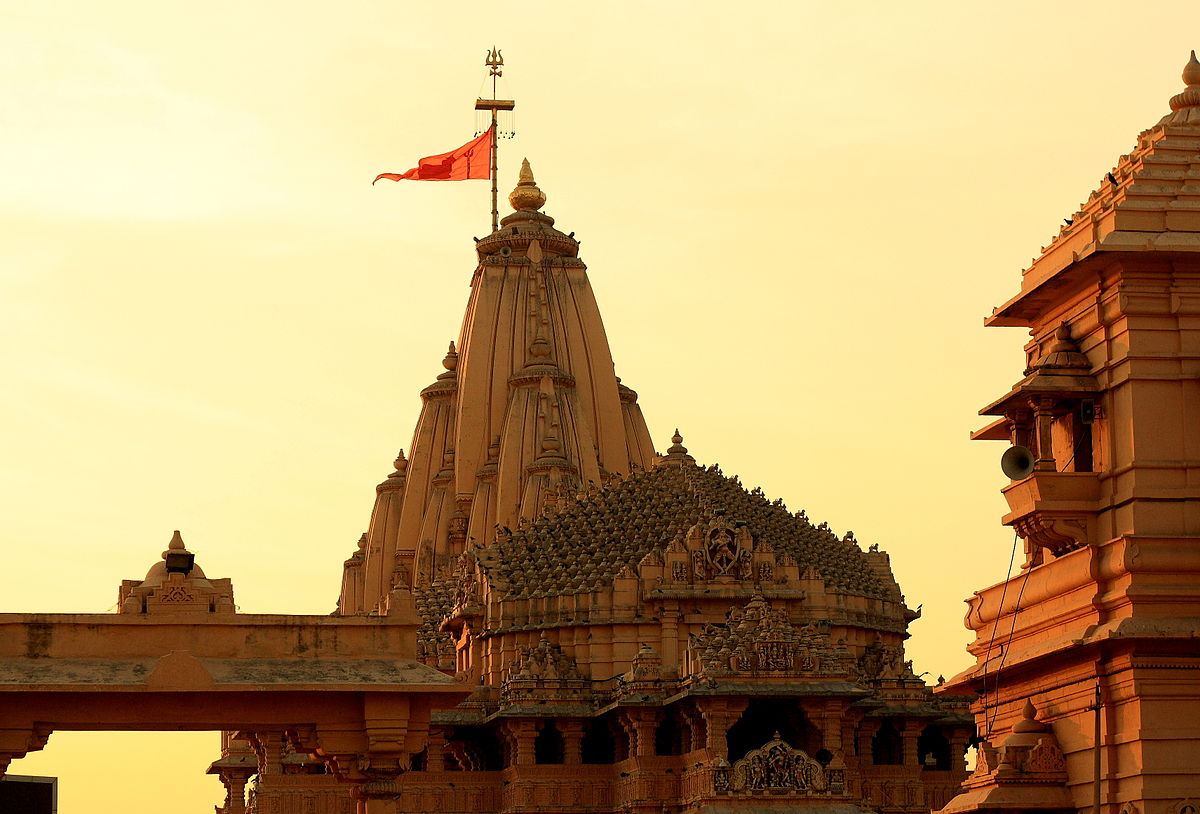


The site of Somnath has been a pilgrimage site from ancient times on account of being a triveni sangam (the confluence of three rivers: Kapila, Hiran and the mythical Saraswati). Soma, the Moon god, is believed to have lost his lustre due to a curse, and he bathed in the Sarasvati River at this site to regain it. The result is said to be the waxing and waning of the moon. The name of the town Prabhas, meaning lustre, as well as the alternative names Someshvar and Somnath ("the lord of the moon" or "the moon god") arise from this tradition.
The history reveals that this temple was continuously looted, destroyed and re-built seventeen times by the Muslim invaders and rulers, especially by Ghazni Mahammmad. Even the original Swayambhu lingam was said to have been destroyed by Ghazni. Another lingam was reinstated at a later date. This temple has significant reverence throughout India and is rich in legend, tradition, and history. It is believed that praying at this temple helps devotees get rid of illness. It’s said that Somraj (the moon god) first built a temple in Somnath, made of gold; this was rebuilt by Ravana in silver, by Krishna in wood and by Bhimdev in stone.
The present temple is built in the Chaulukya style of temple architecture or "Kailash Mahameru Prasad" style. The temple is situated at such a place that there is no land in a straight line between Somnath seashore until Antarctica (South Pole), such an inscription in Sanskrit is found on the Bāṇastambha (arrow pillar) erected on the sea-protection wall. The Bāṇastambha mentions that it stands at a point on the Indian landmass that is the first point on land in the north to the South Pole at that particular longitude.
2. Sri Mallikarjuna Temple, Srisailam
Location: Kurnool District in Rayalaseema, Andhra Pradesh
This Jyothilingam temple is located on a mountain and on the banks of River Krishna. Mallikarjuna is an ancient temple and is architecturally and sculpturally rich. This is also one of the Shakti Peedams. It is said that Saint Adi Shankara composed his Sivaananda Lahiri here. It is also one of the Padal Petra Sthalam of Vada Naadu mentioned in Thevaaram. It is believed that devotees' desire of wealth and prosperity are fulfilled in this auspicious temple.
Several inscriptions found in the temple date back to the Satvahana Dynasty which indicate the temple could have originated during the 2nd century. Several further additions were also made during the reign of king Harihara of the Vijayanagara Empire.
In Vedic times Lord Shiva and his consort Parvati decided to set a competition for their two sons, Ganesha and Kartikeya . It was decided that whoever goes round the world in Pradakshinam would be the first to get the divine fruit. Kartikeya set out on his peacock across the world but, meanwhile, Ganesha went round his parents seven times and according to the Shastras, going round one’s parents once is considered the equivalent of going round the world.
Lord Kartikeya was not too pleased when he returned and decided to retire to Mount Kravunja. He established his abode on the Mount and assumed the name of Kumarabrahmachari. Shiva and Parvati were full of remorse and followed him there (Kumara then started moving out to other hills). The place where Lord Shiva and Parvathi stayed came to be known as Srisailam. It was at this place that devotees started worshipping Shiva with jasmine flowers, which led to Him being called as Mallikarjuna.
The Mallikarjuna temple is regarded as one of the 18 Shakti Peeths which tells the story of Sati, the consort of Shiva. Upon Sati’s immolation by fire, Shiva was distraught and commenced the Tandav dance. Lord Vishnu intervened on behalf of the Gods and severed Sati’s body into 18 pieces. The places where these pieces fell are revered as Shakti Peethas. The Mallikarjuna temple was established at the spot where Goddess Sati’s upper lip is believed to have fallen.
Apart from being one of the 12 Jyotirlingas and Shakti Peethas of India, the Lingam in the shrine is accessible to everyone and devotees are welcome to touch and perform Pujas themselves.
3. Sri Mahakaleshwar Temple
Location: Mahakal, Ujjain (Avanti), Madhya Pradesh
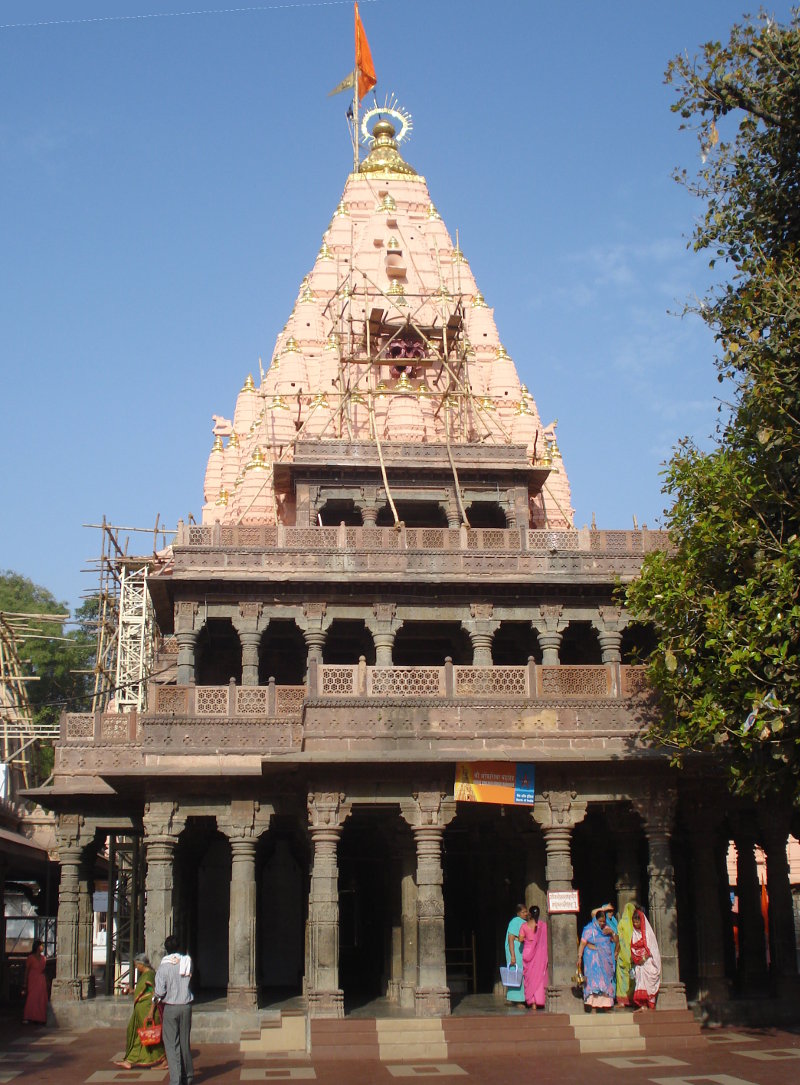
This Jyothirlingam is believed to be a Swayambhu. This lingam is the only one facing south and also the temple to have a Shree Yantra perched upside down at the ceiling of the Sanctum Sanctorum (Garbhagraham). This is also one of the Shakti Peedams. People pray here for getting rid of fear of death.
The Mahakaleshwar temple has been built in Maratha, Bhumija and Chalukya architectural styles. It has five levels, one of which is underground. There are images of Lord Shiva’s consort, Goddess Parvati (to the north), his sons, Ganesha (to the west) and Kartikeya (to the east) and his mount, Nandi (to the south).
On the second floor above the Mahakaleshwar linga is the Omkareshwara linga. Enshrined on the third floor of the temple is an image of Nagchandreshwar – with Lord Shiva and Parvati seated on a ten-hooded snake and surrounded by other statues. It has a tall spire (shikhara) with intricate and beautiful carvings.
It is believed that King Chandrasena of Ujjain was a great devotee of Lord Shiva. While he was praying, a young boy, Shrikhar wished to pray along with him. However, he was not allowed to do so and was sent away to the outskirts of the city. There, he overheard a plot to attack Ujjain by enemy kings Ripudamana and Singhaditya with the help of a demon named Dushanan.
He began to pray to Lord Shiva to protect the city. Vridhi, a priest heard his prayers and also prayed to the Lord to save the city. In the meanwhile, the rival kings attacked Ujjain. They were almost successful in conquering the city when Lord Shiva came in his Mahakal form and saved them. From that day on, at the behest of his devotees, Lord Shiva lives on in this famous Ujjain temple in the form of a linga.
Bhasma aarti (offering with ashes) is a famous ritual here. As ash is pure, non-dual, imperishable and unchangeable, so is the Lord.
4. Sri Omkareshwar Temple
Location: Khandwa District, Madhya Pradesh
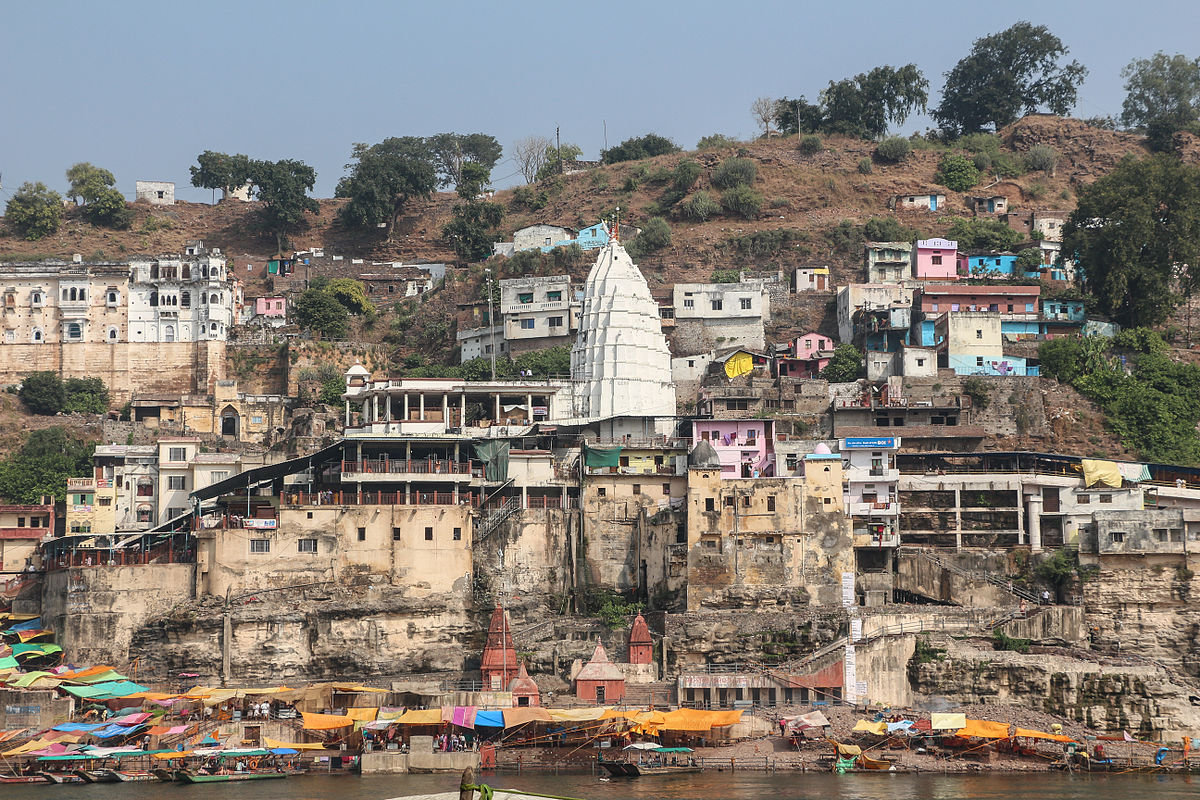

Omkareshwar is a beautiful self-manifested (Swayambhu) lingam. On the banks of river Narmada, there is a huge island on which the Jyothirlingam “Omkaram Amaleshwar” temple is situated. This island and the river are shaped like “OM” and that is how it derives its name.
It is a natural phenomenon. Brahma and Vishnu also lived in the same place as Omkar Amaleshwar. That is why on the banks of Narmada Brahmapuri, Vishnupuri and Rudrapuri are built which are known as Tripuri Kshetra.
The Amareshwar Jyothiringam is situated in Rudrapuri. Sri Mamaleshwar temple is also situated here. The devotees who go around the temple consider themselves blessed because they are doing a Parikrama or Circumambulation of Omkara and also believe that they would be free from obstacles in their life.
One legend says that two sons of emperor Mandhata of the Ikshvaku dynasty performed severe austerities and pleased Lord Shiva because of which the mountain is called Mandhata Mountain. And Lord Shiva manifested himself as a jyotirlinga.
Another legend says that Vindhya Parvat prayed to Lord Shiva performing severe penance to make the Vindhyas, His abode. Some say it was to become taller than Mount Meru. Lord Shiva was pleased with the penance and granted his wish by appearing as a jyotirlinga there.
At the behest of the gods and sages, Lord Shiva split the linga into two parts – one is at Omkareshwar and the other at Amareshwar or Mamleshwar. Therefore, devotees visit both these temples when they visit Mandhata.
It is said that Lord Shiva also allowed the Vindhyas to grow but only as long as he did not trouble the pilgrims. However, over time, Vindhya Parvat’s massiveness did cause problems for the devotees and so they sought sage Agastya’s help. The sage ordered the mountain to stop growing until he returned to it, which he never did, and hence he solved the devotees’ problem.
5. Sri Kedarnath Temple
Location: In Uttarakhand and is about 200 kms from Rishikesh
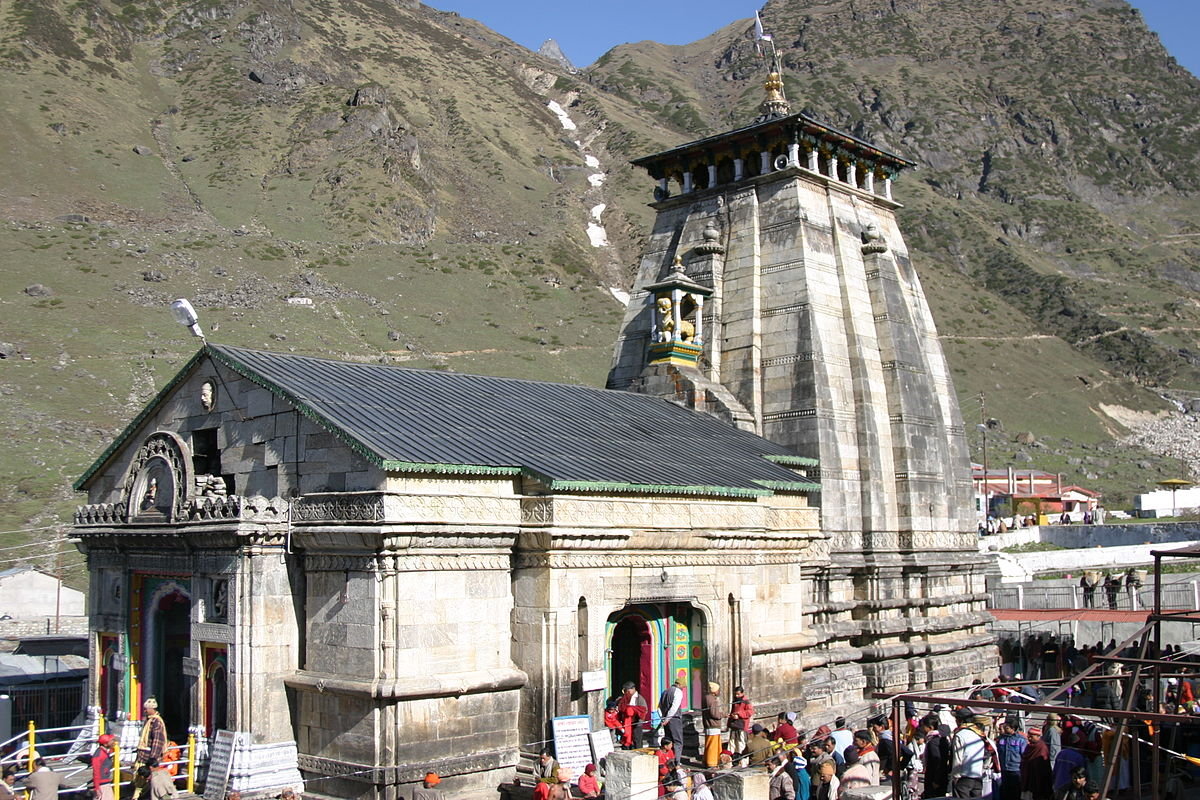
Kedarnath is revered as the northernmost and the closest Jyothirlingam to Lord Shiva's eternal abode of Mount Kailash. Kedarnath, nestled in the snow clad Himalayas, is an ancient shrine, rich in legend and tradition. It is accessible only for six months in a year (May to October). The Shivalingam here is self-manifested and not installed by anyone and is triangular (pyramid) shaped.
One of the first references of Kedarnath is in the Skanda Purana that was written around the 7th and 8th century AD. The present structure is believed to have been constructed by Adi Shankaracharya about 1,200 years ago. It stands next to the site of a temple that is said to have been built by the Pandavas.
The legend is that Pandavas were on pilgrimage to Kailash after the war, to seek the blessings of Lord Shiva and to absolve themselves from the sin due to the killing of their kith and kin. On their way, Bheema met an unique Mahisha (he bufallo) and he wanted to catch it but the buffalo had hidden its face in the earth. Bheema tried to pull it out but in vain. However, Lord Shiva, Who was hiding in the form of the bufallo dug himself deeper and only reappeared in parts in different places - the hump in Kedarnath, the arms in Tunganath, the navel and stomach in Madhyamaheshwar, the face in Rudranath, and the hair and head in Kalpeshwar. The Pandavas built temples at these five places – the Panch Kedars - for worshipping Shiva. This freed them from their sins.
But from this hind part of the bufallo, a glorious Jyothirlingam appeared and blessed the Pandavas. It is said that its hind part stayed here as Swayambhu Lingam and its face went straight to Nepal, where it is known as Pashupathinath.
Kedarnath is also one of the Paadal Petra Sthalams of Vada Naadu mentioned in Devaram.
6. Sri Bhimashankar Temple
Location: Near Pune Maharashtra

Bhimashankar is very much debated because in 3-4 other places also it was claimed as Bhimashankar temple. Lord Shiva temples in Kashipur in Uttarakhand, Sahyadri in Maharashtra, Guwahati in Assam and Bhimpur in South Orissa are said to be the Bhimashankar. However, the temple near Pune is considered more auspicious and accepted as Bhimashankar by the people.
There was once a demon called Bhima, whose parents were Kumbhakarna and Karkati. Demon Bhima was harassing and torturing all, who were followers of dharma.
When he heard that his father was slain by Sri Rama, he was at once eager to take revenge against all the divines along with Ram. He began a severe penance and a pleased Brahma granted him a boon for strength. With this new strength, he captured all the gods including Vishnu and Indra. After this he won a victory over a devotee of Lord Shiva, by name, Kamarupeshwar. Kamarupeshwar did not stop his worship of Shiva even while in prison. He performed Shiva Puja with the same devotion, observing all the procedures.
On the other hand, Brahma and Vishnu along with all the other divines prayed to Lord Shiva for liberating the gods from the wicked Demon King. Shiva assured the divines and sent them home after pacifying them.
Bheema smelt that Kamarupeshwar was making preparations to kill him and started inquiring into the aim of his worship. The wicked Demon called Lord Shiva names and insulted Him and ordered Kamarupeshwar to worship Bheema himself instead. When Kamarupeshwar resisted, Bheema attacked the Linga with his sword. Before he could strike, Lord Shiva appeared there and opened his third eye and burnt the wicked Demon Bheema to ashes. The divines and saints who were present there, pleaded with Lord Shankara to stay there permanently. Lord Shiva agreed to stay there as an incarnation as Bheema Shankar Jyotir Linga.
7. Sri Kashi Vishwanathar Temple
Location: Varanasi (Kasi) Uttar Pradesh
The Vishwanath,(the Lord of All), temple is situated in Varanasi, also known as Benaras or Kashi, the spiritual capital for Hindus, where a Hindu is expected to make a pilgrimage at least once in his life time, and if possible, also pour the remains of cremated ancestors on the river Ganges.
The temple stands on the western bank of the holy river Ganges. Another significance of this temple is that this is also one of the 51 Shakti Peedams. This temple town, is considered to be the oldest living city in the world, with 3500 years of documented history. People visit this world famous temple to attain “moksha”.
Beside its religious significance, the temple is also an architectural marvel. The magnificent edifice offers a breathtaking view to the onlooker. It is said that once Lord Shiva came in the dream of Rani Ahalya Bai Holkar of Indore. She, being a devotee of Lord Shiva, got the current temple built in 1777. The temple is popularly known as the Golden Temple, due to the massive gold plating on its shikhara (spire)
Deeply and intimately implanted in the Hindu mind, the Kashi Vishwanath Temple has been a living embodiment of our timeless cultural traditions and highest spiritual values. The Temple has been visited by all great saints- Adi Shankaracharya, Ramkrishna Paramhansa, Swami Vivekanand, Goswami Tulsidas, Maharshi Dayanand Saraswati, Gurunanak and several other spiritual personalities.
8. Sri Triambakeshwarar Temple
Location: Near Nashik, Maharashtra



Trimbak, as Trimbakeshwar is often called, is a town that lies in the shadow of the Brahmagiri Hill, the source of the holy Godavari river. According to the prayer of Gautam Rishi and other saints, Lord Shiva chose to live in this place. The widest seven hundred stairs lead to the temple atop Brahmagiri mountain of Shivpuri. After climbing these stairs, 'Ramkunda' and 'Laxmankunda' are met, and on reaching the summit, there are visions of Bhagwati Godavari, coming out of Ghumukh.
The garba graha (sanctum sanctorum) is a few steps below the ground and on payment of certain fees we can enter and do abishekam with certain conditions. The Shiva Linga present inside the temple is called as Trimbaka, denoting the three eyes of Lord Shiva. The three small (hardly 6 inches) sized Lingas represent Brahma, Vishnu and Shiva present in the 'Avudayaar' (pedestal where Siva Lingam is seen) at the floor level of the sanctum. The lingams are normally covered with a silver mask and, on festivals, a golden crown is adorned on the lingas.
Trimbakeshwar Jyotirlinga Temple story from Shiva Purana
Once, the wives of few Brahmins living in Tapovan of Maharishi Gautam became angry with Gautam's wife, Ahilya, on some pretext. They instigated their husbands to torture Gautam Rishi and drive him out. Those Brahmins were highly devoted to Lord Ganesha. Ganesha was pleased and decided to give them a boon. Those Brahmins requested Him to help them in driving Saint Gautam from the ashram. Much as Ganesha explained to them that He cannot grant them such a boon, they remained firm on their insistence.
Eventually, Ganesha had to comply and asked them to follow his advice. To satisfy his devotees, he took the form of a weak cow and started living in the farm of Gautam Rishi. Seeing the cow grazing the crop, the sage got hold of a dharba grass to drive it away. The moment he touched the cow with the grass, the cow fell down dead.
All the Brahmins started accusing Gautama as a murderer of holy cow, condemning his action. Gautam Rishi was very surprised and sad from this incident. All the Brahmins shouted that he should leave the ashram and move away elsewhere.
Gautam, along his wife Ahilya, went out to a far away place. But the Brahmins followed him everywhere to drive him farther away and insulted him, saying that he had no right to do any work on Vedas and Yagya, because of the sin associated with the cow slaughter. Gautam Rishi prayed to the Brahmins asking them for a remedy.
Maharishi Gautam then completed all the difficult tasks and became completely engrossed with his wife and worshiped Lord Shiva for help to get rid of the sin. Lord Shiva was pleased with this and said, 'Gautam! You are completely innocent. The crime of murder was planned against you. I want to punish the Brahmins of your ashram, who have done this by deceit. '
Maharishi Gautam pleaded for Lord Shiva's mercy for the Brahmins, quoting that but for them he would not have had the Dharshan of Lord Shiva. All the brahmins, many sages and Divinities including Lord Vishnu and Lord Brahma gathered there to have a glimpse of the Lord, and prayed to Lord Shiva to dwell there permanently. Ganges then started flowing down from Lord Shiva's siras as River Godavari.
9. Sri Nageshvarar Temple
Location: in Jageshwar, Darukavanam, Near Dwaraka, Gujarat. 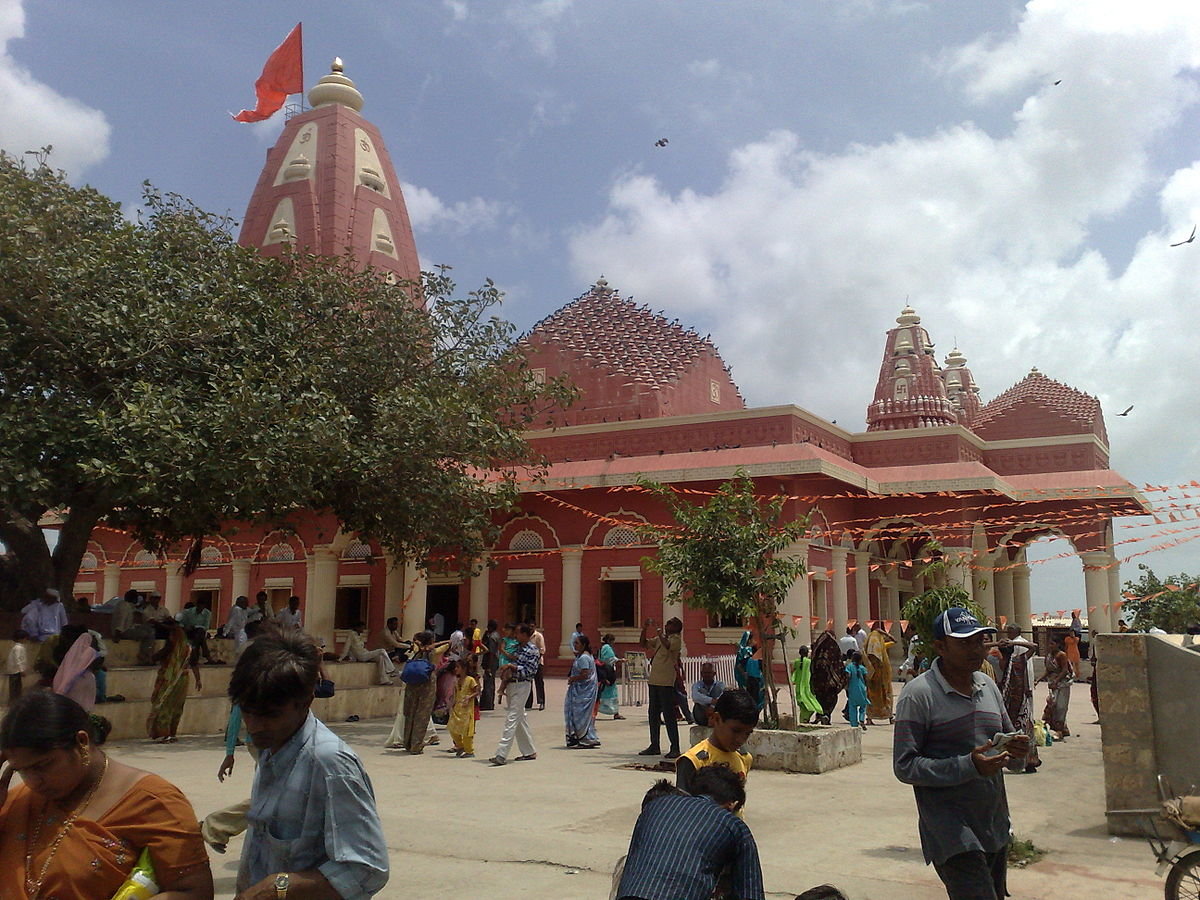

There is a huge statue (25m) of Lord Shiva in a sitting position, a large garden and a pond in this temple. The linga is made of Dwaraka shila and has small chakras on it. It is in the shape of a tri-mukhi rudraksha (sacred beads representing Lord Shiva) and faces south, while the temple faces east.
The legend goes that there was once a demon called Daruk who lived in the forest along with his wife, Daruka. Because of a boon from Goddess Parvati, the demons had great powers which they abused to disturb festivities. They even captured and imprisoned a great devotee of Lord Shiva – a merchant named Supriya. Even in prison, Supriya continued his Shiva puja, wearing the holy rudraksha and chanting the Shiva mantra - Om Namah Shivaya. His devotion touched the Lord as he appeared before him, slayed the demon and saved him. The place where the demon was killed is called Daarukavanam. It is said that the Lord placed the Shiva Linga (called Naganath) there to establish his residence there.
There is an interesting story behind why the linga faces south. Legend has it that a devotee called Naamdev was asked by other devotees to step aside and not hide the Lord while chanting his name. Naamdev asked the others to suggest a direction where the Lord does not exist. The angry devotees carried him to the south and left him there. They were astonished to find that the linga was also facing south!
It is also believed that Lord Krishna himself used to worship Lord Shiva here; he is said to have performed the rudrabhishekam here.
10. Sri Baidyanath Temple
Location: In Santhal Parganas, Deoghar, Jharkhand 
Baidyanath Jyothirlinga temple, also known as Baba Baidyanath Dham, is a temple complex consisting of the main temple of Baba Baidyanath, where the Jyothirlingam is installed, and 21 other temples. According to Hindu beliefs, the demon king Ravana worshipped Shiva at this place to get the boons that he later used to wreak havoc in the world.
Ravana offered his ten heads one after another to Lord Shiva as a sacrifice. Pleased with this, Lord Shiva descended to cure Ravana who was injured. As he acted as a doctor, he is referred to as Vaidhya ("Doctor") hence, the lord and the place got this name.
11. Sri Rameshwar Temple
Location: In Rameswaram, Tamil Nadu


The huge Ramalingeswarar Jyothirlingam temple is revered as the southern most of the twelve Jyothirlingam shrines of India. It enshrines the Ramesvara ("Lord of Rama") pillar. The temple is one of the holiest Hindu Char Dham (four divine sites), comprising Badrinath, Puri, Dwarka and Rameshwaram.
According to legend, this is the place from where the Lord Rama built a bridge across the sea to Lanka to rescue Sita from her abductor Ravana. And, on His return from Lanka after killing Ravana, Rama offered prayers to Lord Shiva here to remove brahma-hathi Dosham. In order to do that, Rama sent Hanuman to Himalayas to bring a holy lingam, but as it was getting delayed, Sita made a Lingam out of the beach sands and Rama performed the pooja. Later Hanuman also brought the Lingam from North. Hence there are two lingams in this temple, one called Rama Lingam and other Shiva Lingam.
It is also one of the Paadal Petra Sthalams of Pandya Naadu mentioned in Devaram. This is one of the holy places that a Hindu wish to visit during his lifetime. It is believed that Lord Shiva fulfils devotees desire of winning over their enemies.

The outer set of corridors is reputed to be the longest in the world, measuring about 6.9 m in height, 400 feet each in the east and west and about 640 feet in the north and the south. The inner corridors are about 224 feet each in the east and the west and about 352 feet each in the north and the south. Their width varies from 15.5 feet to 17 feet in the east and west about 172 feet on the north and south with width varying 14.5 feet to 17 feet. The total length of these corridors is thus 3850 feet. There are about 1212 pillars in the outer corridor. Their height is about 30 feet from the floor to the center of the roof. The main tower or rajagopuram is 53 m tall.
12. Sri Grishneshwar Temple
Location: Near Village Verul, Aurangabhad District, Maharashtra
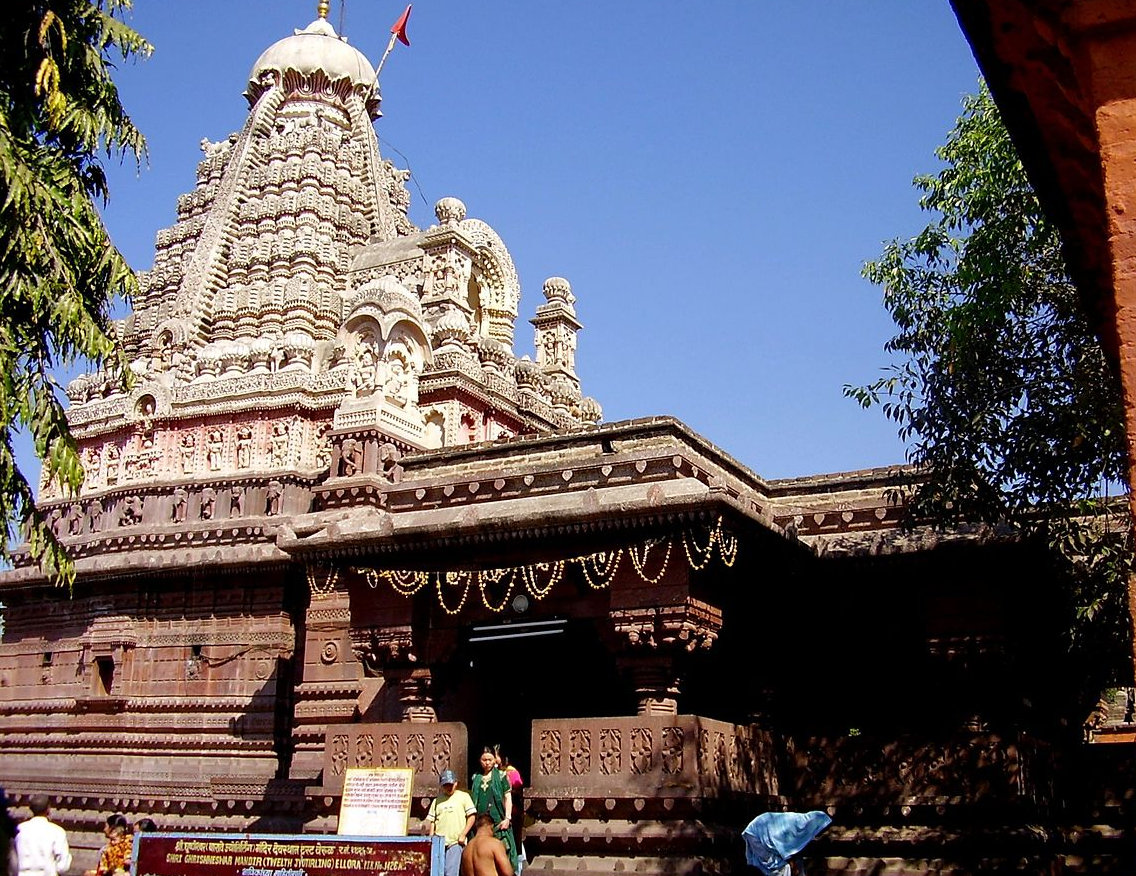

Grishneshwar Jyothirlingam is one of the twelve Jyothirlingam shrines mentioned in the Shiva Puranam "kotirudra Sahinta", referred as 'Ghushmeshwar Jyothirlingam'. Ghushmeshwar is believed as the last or the twelfth Jyothirlingam on earth. It is believed that praying here helps lost family members re-unite.This temple is situated just adjacent to the famous Ellora Caves.
The legend goes that there was a Brahmin called Brahmavetta Sudharm, who lived with his wife Sudeha in the Devagiri mountains. The couple was childless, so Sudeha got her sister Ghushma married to her husband. On her sister’s advice, Ghushma would make lingas, worship them, and immerse them in the lake nearby. She was, finally, blessed with a baby boy. Over time, Sudeha became jealous of her sister and murdered her son and threw him into the very lake where her sister would immerse the lingas.
Though Ghushma’s daughter-in-law told her that Sudeha had a hand in the murder of her son, Ghushma continued her daily rituals believing totally in the Lord’s mercy. And true to her beliefs, as she went to immerse the linga, she saw her son walking towards her. Lord Shiva appeared before her and told her of her sister’s heinous deed.
Ghushma requested the Lord to forgive her sister. Pleased, the Lord granted her a boon. She asked him to stay on in that place, which is why he manifested himself as a jyotirlinga called Ghushmeshwar. The lake in which Ghushma immersed the lingas was called Shivalaya.

https://www.youtube.com/watch?v=HqqmFc7zElU&list=WL&index=9
Thats all for now, ...... till we meet again in my next blog.
AUM NAMASHHIVAYA




